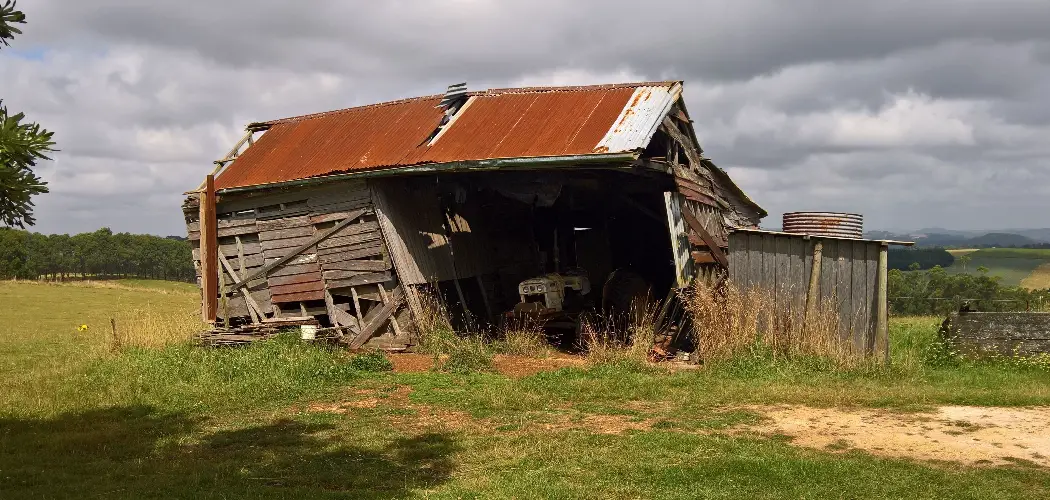Are you looking for a way to stabilize your leaning shed? Perhaps the wind has knocked it over, or its foundation has started to become unstable – no matter what’s caused it, there’s a simple solution.
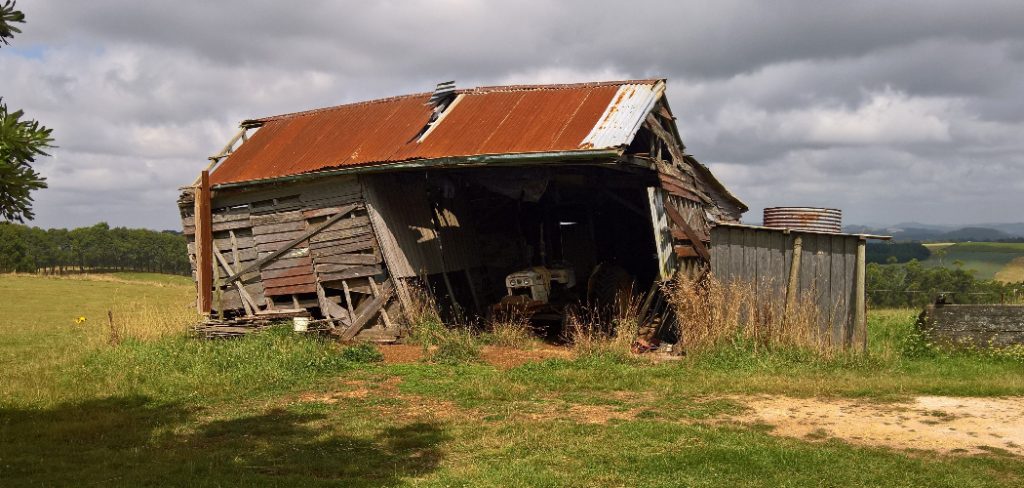
In this blog post, we provide easy instructions on how to fix a leaning shed as well as advice on how to prevent future issues from arising. Read on to learn more about repairs for your backyard structure and be sure that your shed stands strong into the future!
Tools You Will Need:
Shovel:
You will need a shovel to dig out the foundation of your shed and help level the ground.
Level:
A level will help ensure that your shed is on a flat surface after the repairs are complete.
Gravel:
Gravel is essential for creating a sturdy foundation for your shed.
Wood Post(s):
You will need one or more wood posts to support your shed.
Concrete Mix:
This will be used to secure the wood post(s) in place.
Hammer:
A hammer will come in handy for securing the wood post(s) and other materials.
Nails or Screws:
Depending on the type of shed, you may need nails or screws to secure any loosened panels or parts. Make sure to use the appropriate size and type.
Brackets:
Brackets can also be used to reinforce the structure of your shed. Choose heavy-duty brackets for extra support.
10 Steps on How to Fix a Leaning Shed:
1. Dig Around the Shed Foundation
To fix a leaning shed, start by making sure that the area around the foundation is structurally sound. Begin by digging around the base of the shed and inspecting for any loose soil or erosion where it is leaning. Any weak spots can be replaced with new fill and dampened down before putting any remains back in place.
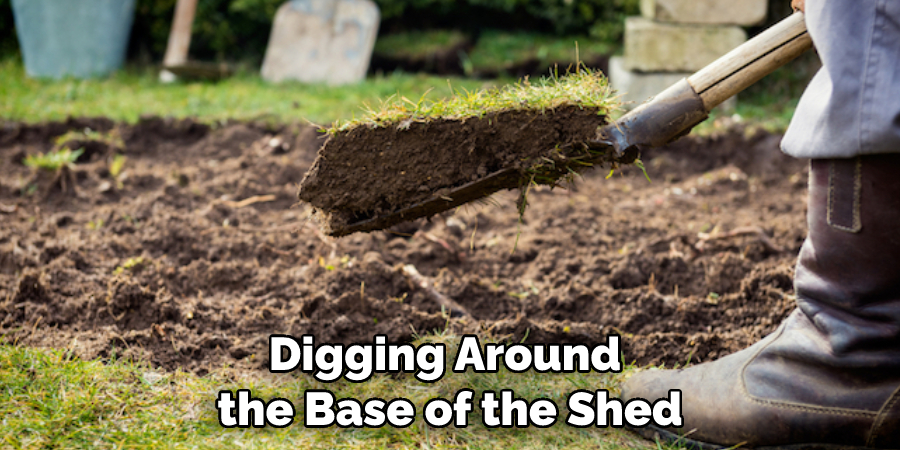
Check to make sure that the area is filled properly and securely compacted. It’s important to ensure that there aren’t any dips or hollows where water might gather, as this can lead to further weakening of the structure over time. After this initial step, you’ll be ready to move on to stabilizing your lean using shims, wedges, and braces if needed.
2. Determine How Much Repair Work Needs
A leaning shed can be a real headache when it comes to repairs. To make sure you’re successful in fixing the issue, you can use a level to see how square your shed is to the ground. If it’s not square, you’ll need to do some work to get it back in line. You may need to hammer stakes into the ground and temporarily brace up opposite sides of your shed with 2x4s while also securing them together with wood screws or corner braces.
Then, slowly let down one side at a time until all buildings are lined up evenly – allowing the built-in braces and screws to hold everything securely in place going forward. By using a level, you’ll know exactly what needs to be done for a thorough repair job and you’ll be able to fix the leaning shed successfully.
3. Ensure a Level Foundation
Ensuring a level foundation is an important part of any shed installation, as it helps keep things even and stable. Adding gravel around the base can help create a more secure foundation for a building.
Depending on your terrain, the amount of gravel you need might vary, but the extra attention to this critical step can help prevent any future leaning and ensure that your shed stays upright and strong for many years to come. It’s easy to forget something like this when assembling a structure in a hurry, but taking the time to do it correctly from the start makes all the difference!
4. Prop the Shed
If your shed is starting to lean, the best way to start fixing it is by propping it back into an upright position. The most effective way to do this is by using wood posts, as they create a stable foundation for the support structure and provide stability while repairs are made. It’s a good idea to anchor them with either earth or concrete if your shed is large, or you can secure them directly onto the shed frame if it’s a smaller building.
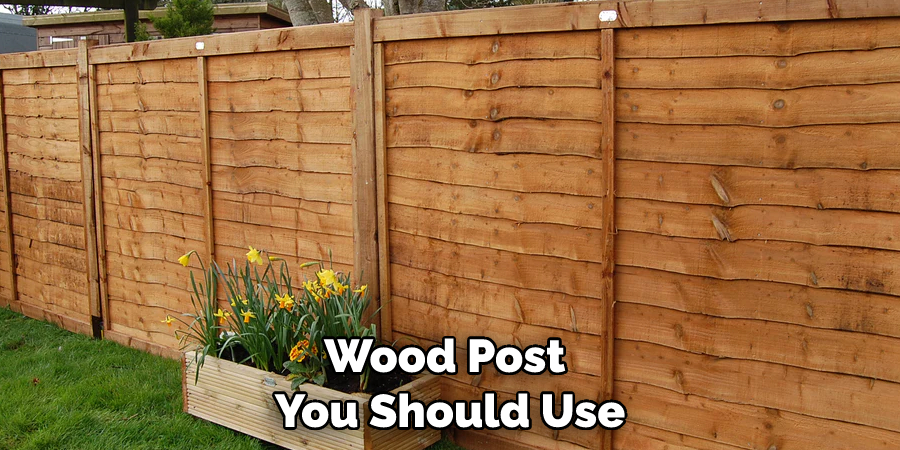
When choosing which type of wood post you should use, make sure that it will last through all weather conditions, as well as be able to hold the weight of the entire shed without snapping. With careful selection and placement of wood posts and making sure that any damage is fixed properly, you should be able to fix a leaning shed in no time!
5. Mix Concrete and Use It to Fill
If your shed is leaning, it may be time to reinforce its foundation. One way to do this is to mix concrete and use it to fill in any gaps or holes around the base of the shed. This will help stabilize the structure and prevent it from falling. Before you begin mixing concrete, make sure you have the necessary supplies – such as a shovel, bucket, concrete mix, etc. If needed, remove any dirt or rocks from the area first.
Once all of your supplies are gathered, combine water and concrete mix in a bucket using the proportions specified on the bag of concrete mix. Then, pour or spoon the mixture into any holes around the shed and spread it evenly with a trowel before allowing it to dry for 24 hours. Following these simple steps can help ensure your shed stays safe and secure for years to come!
6. Secure Your Shed in Place
To complete the process of fixing a leaning shed, one must first make sure that the concrete is completely dry. Once this has occurred, using nails or screws to secure the shed in place is an ideal way to ensure that it will remain firmly in its rightful position. It is important to note that not all screws are made equal, and hardware stores often carry a wide array of various types of screws and nails to suit any mounting application.
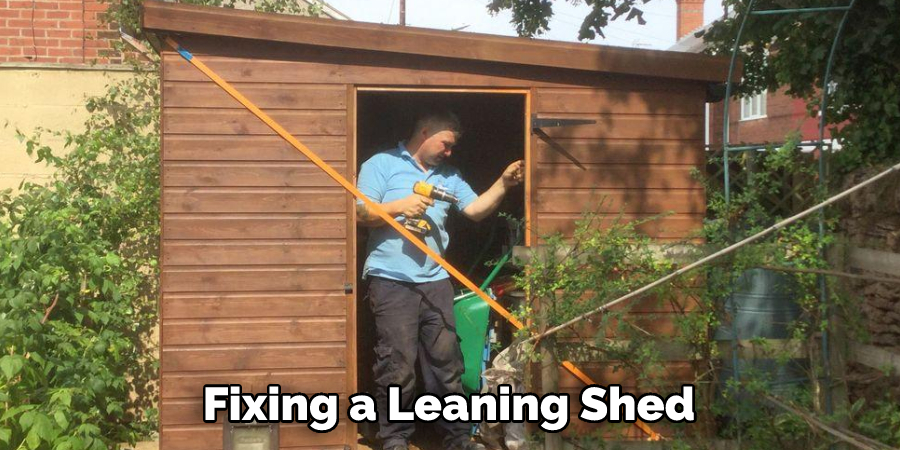
If you’re unsure what type of screw will work best for your situation, try a few different types to see which holds the best. You can always remove them later and then replace them with the most secure type. A final touch-up using brackets or braces in strategic areas may also help reinforce the structure, depending on its size.
7. Replace Any Damaged or Rotten Pieces
If your shed is leaning due to damage or rot, it may be necessary to replace any affected pieces before attempting to fix the lean. This will help prevent further weakening of the structure and ensure that your repairs last longer.
Make sure to carefully inspect all areas of the shed to identify which parts need replacement. Once this is done, remove the damaged pieces and replace them with new ones. Be sure to properly secure them before moving on to the next step of the repair process.
8. Regular Maintenance
Regular maintenance is key to preventing future leaning or structural issues. This includes checking for any signs of damage or rot and addressing them promptly, as well as ensuring a level foundation and proper anchoring of the shed.
Additionally, keeping the shed clean and free of clutter can also help prevent any added weight or strain on the structure. Regularly inspecting and maintaining your shed can save you time and money in the long run by preventing major repairs or even a full replacement.
9. Consider Professional Help
If you’re unsure about how to fix a leaning shed or if the damage is extensive, it’s always a good idea to seek professional help. A licensed contractor or experienced builder can help assess the situation and provide expert guidance on the best course of action. They may also have access to specialized tools or methods that can make the repair process easier and more efficient.
10. Enjoy Your Sturdy Shed!
By following these steps and taking the necessary precautions, you can successfully fix a leaning shed and ensure that it remains sturdy for years to come. Remember to always prioritize safety and seek professional assistance if needed. With proper maintenance and care, your shed will continue to serve its purpose as a functional and reliable storage space.
Installing the right kind of fastener with your particular type of shed material will not only keep it securely in place but also guarantee that future wear and tear from outside forces are minimized. Making sure to fasten your shed correctly the first time will pay off for many years to come!
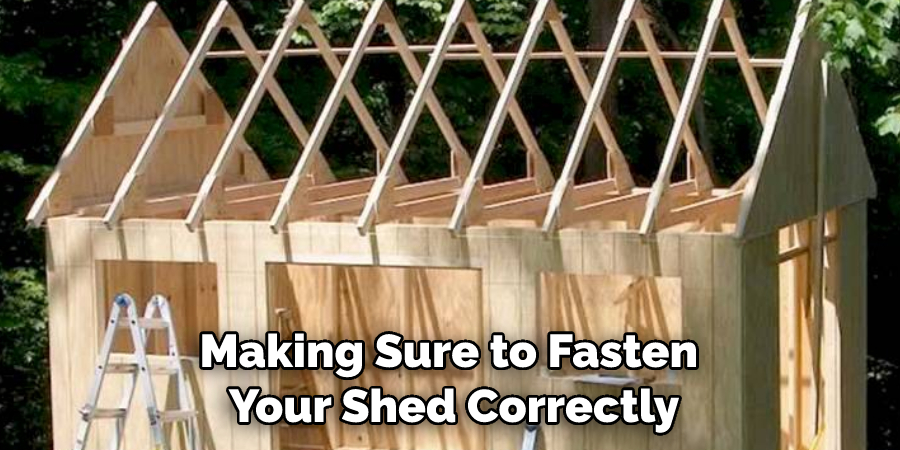
By following these simple steps, you can quickly and easily repair your leaning shed so that it stands straight and secure again. Additionally, be sure to inspect the foundation of your shed periodically throughout the year to keep an eye out for any potential problems. With a little bit of maintenance, you can be sure to keep your shed in top condition for years to come.
Tips on Fixing a Leaning Shed
1. The first step in fixing a leaning shed is to check the foundation. If the shed is sitting on an uneven or weak foundation, the shed will likely continue to lean or even collapse over time. To fix this problem, you will need to level out the foundation and/or replace any damaged or missing support beams.
2. Next, you will need to check the walls of the shed. If the walls are made of wood, make sure that they are securely attached to the frame of the shed. If the walls are made of metal, check for any dents or damage that could be causing the shed to lean. Once you have identified any damage, you will need to repair or replace the affected materials.
3. Another possible cause of a leaning shed is a damaged or poorly installed roof. If the roof is not properly attached to the walls and/or frame of the shed, it can cause the shed to lean. Additionally, if there is damage to the roof, such as a hole or crack, it can also allow water to enter the shed, which can lead to further damage and instability. To fix this problem, you will need to repair or replace any damaged materials and/or properly re-attach the roof to the shed.
4. If you are unable to identify and fix the root cause of the problem, you may be able to temporarily stabilize the shed by using braces. Braces can be placed on either side of the shed and attached to either the ground or another structure (such as a fence). This will help to prevent further movement of the shed until you can make more permanent repairs.
5. If you are unsure of how to fix your leaning shed or do not feel comfortable making repairs yourself, it is best to call a professional for assistance. A professional will be able to quickly identify and fix any underlying problems with your shed so that it is safe and stable once again.
How to Level Out an Unstable Shed Foundation?
If your shed is built on an unstable foundation, you can easily level out the area using specific tools and materials. Start by using a torpedo or laser level to check the grade of the shed foundation. It should be level with no more than 4 4-inch difference from one end to the other. If it’s not level, consider excavating around the perimeter and adding a layer of compacted gravel to add depth and extra support.
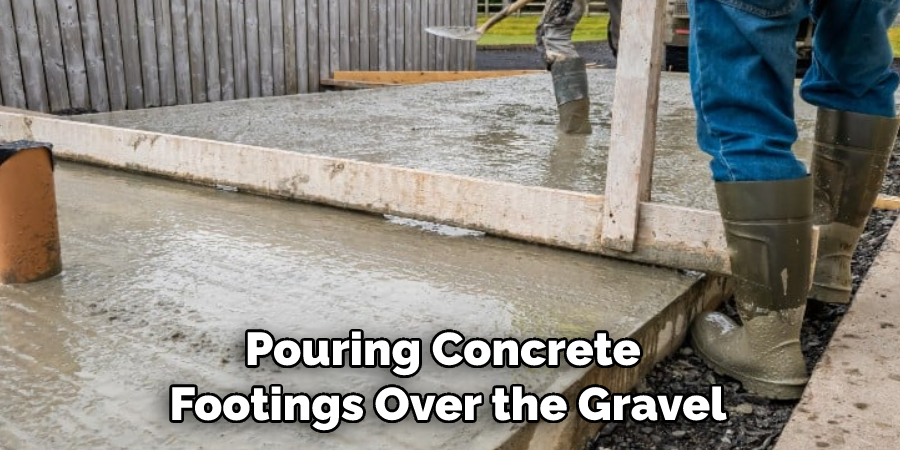
Pack down each corner before pouring concrete footings over the gravel. Be sure to add vertical post supports so your shed walls have added stability and protection against erosion. With these techniques, you’ll have a visually appealing, solid foundation that’ll keep your shed upright for years to come!
What You Need to Know Before Replacing a Damaged Roof on Your Shed?
Replacing a damaged roof on a shed can be more involved than it appears. The main concern is to identify the root cause of the damage, whether that be rough weather, age, neglect, or something more serious. Evaluating the condition of your shed and its existing roofing system is essential for deciding how extensive the replacement needs to be — just patching a few spots or replacing an entire section of the roof may be necessary. Additionally, it’s important to choose durable materials that are suited to your local climate conditions. Failing to do so could lead to additional damage down the road.
Before starting the job, make sure you assess your skills and tools and understand what kind of intensive labor is involved in replacing a shed’s roof. Taking all these factors into consideration will ensure that your new roof will keep you and your belongings safe from weather considerations for many years down the line.
Frequently Asked Questions:
Q: How Do I Know if My Shed Has a Damaged Foundation?
A: Signs of a damaged foundation can include cracks in the concrete or unevenness in the shed’s structure. You may also notice that the shed is leaning to one side or appears unstable. If you suspect that your shed has a damaged foundation, it is important to address the issue as soon as possible to prevent further damage or collapse.
Q: Can I Use Concrete Blocks Instead of Pouring a Concrete Foundation?
A: While using concrete blocks may seem like an easier and cheaper alternative, it is not recommended for shed foundations. Concrete blocks can shift over time and cause instability in the shed, potentially leading to more serious problems. Pouring a concrete foundation is a more reliable and long-lasting option for your shed’s stability.
Q: How Often Should I Check the Foundation of My Shed?
A: It is recommended to check the foundation of your shed at least once a year, especially after severe weather or if you notice any changes in the shed’s stability. This will help you catch any potential problems early on and prevent them from escalating. Regular maintenance is key to keeping your shed in top condition for years to come.
Conclusion
If your shed is leaning, don’t despair! With a few tools and some elbow grease, you can fix it yourself. You should carefully determine how to fix a leaning shed. Dig around the base of the shed to see if there are any obvious problems. If the ground is uneven, you may need to level it out with some sand or dirt.
Once the ground is level, check the support beams to see if they’re straight. If they’re not, you’ll need to use a come-along or ratchet strap to pull them back into place. Finally, check the roof to make sure that it’s secured properly. If it’s not, screw or nail it down tight. With these simple steps, you can get your shed back in shape in no time!
You Can Check It Out to Attach Wood Stair Treads to Concrete

